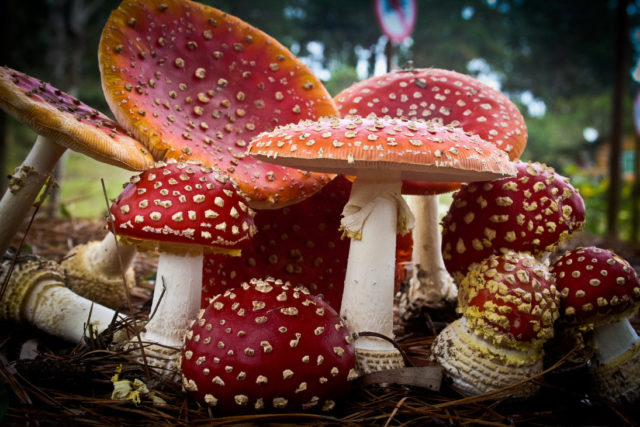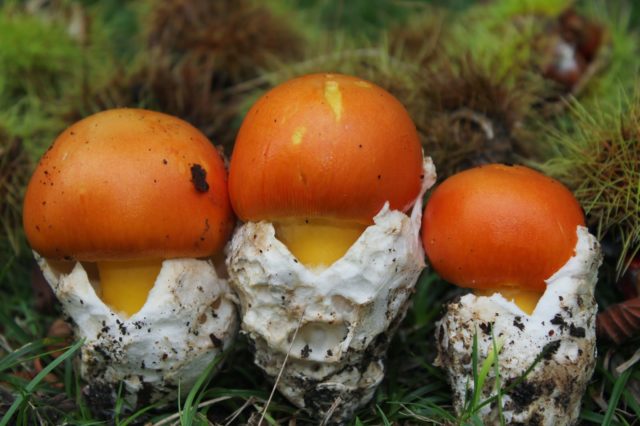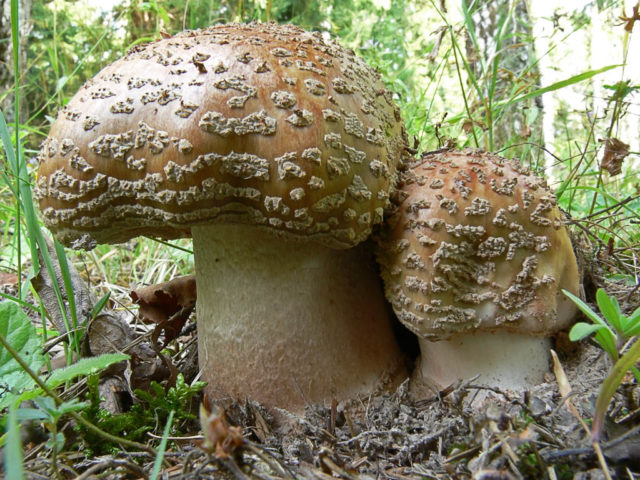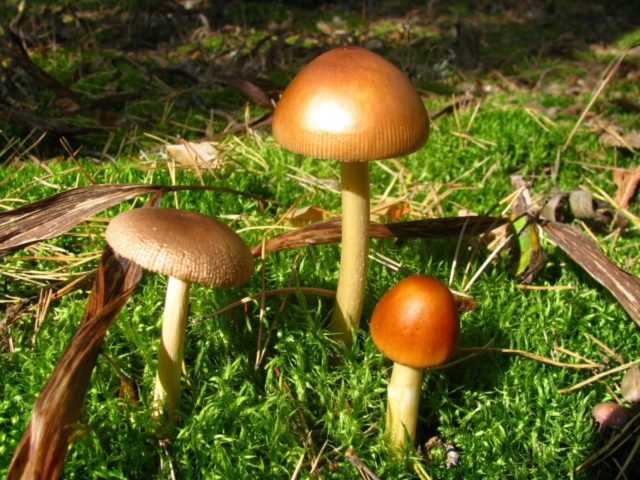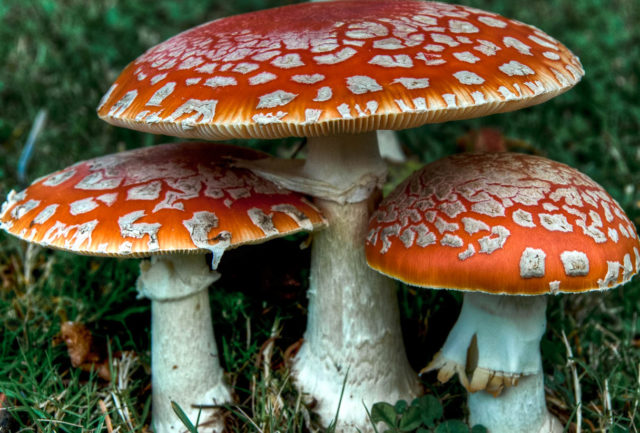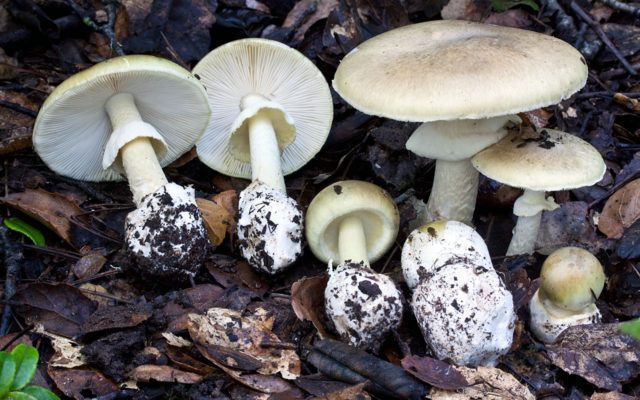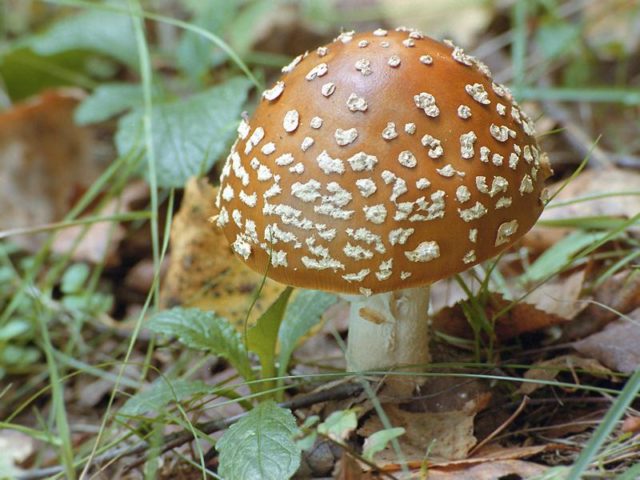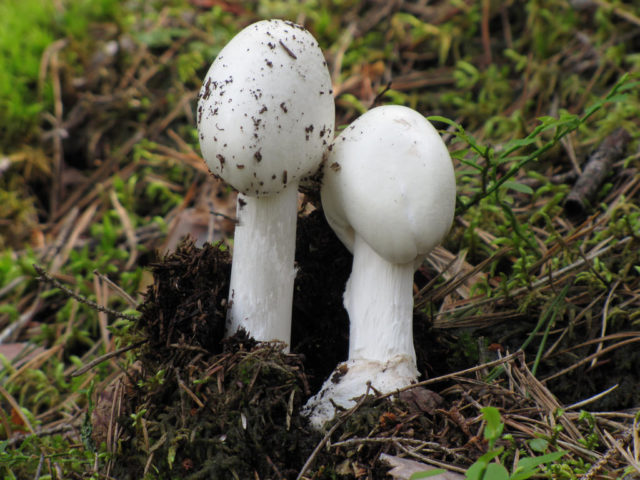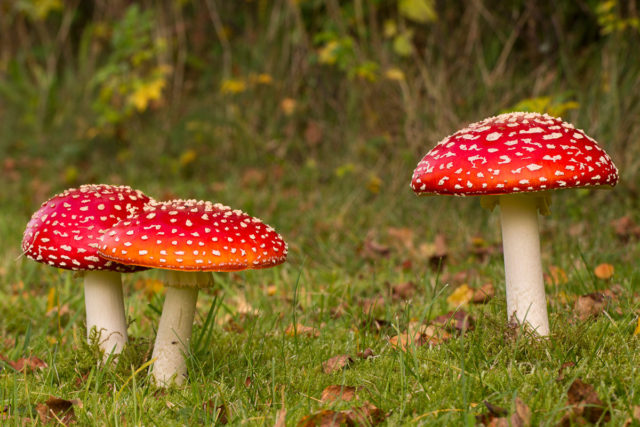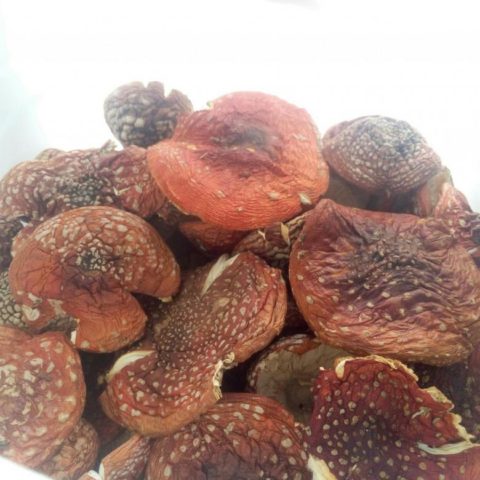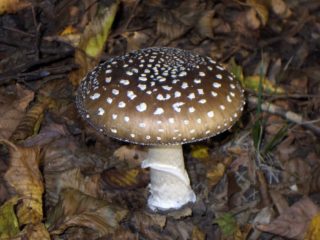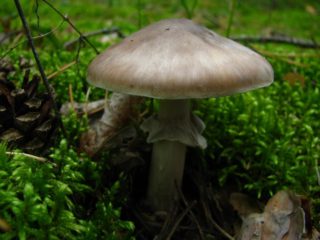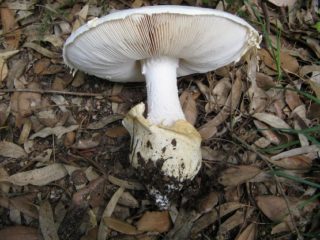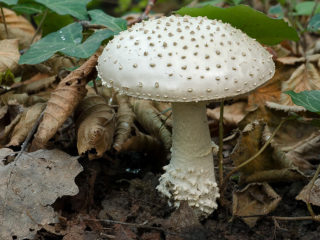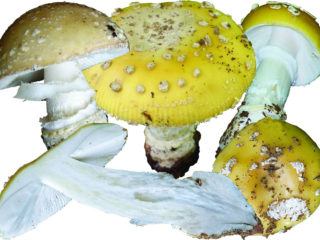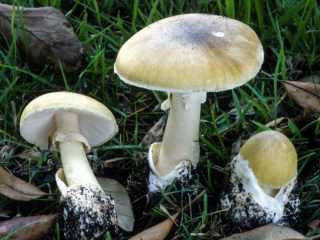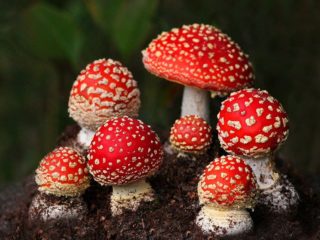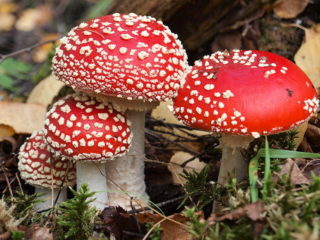Content
- 1 What does a fly agaric look like?
- 2 Types of fly agarics with photos and descriptions
- 3 When fly agarics grow in the forest
- 4 What happens if you eat raw fly agaric
- 5 Symptoms of fly agaric poisoning
- 6 Is collecting fly agaric prohibited in Russia?
- 7 Interesting facts about the use of fly agarics
- 8 Conclusion
The name “fly agaric” unites a large group of mushrooms that have similar characteristics. Most of them are inedible and poisonous. If you eat a fly agaric, you will experience poisoning or a hallucinogenic effect. Some varieties of these mushrooms are considered edible, but you need to be able to distinguish them from dangerous representatives.
What does a fly agaric look like?
All representatives of this group are large in size. The leg is central, in young specimens it is located in a common veil. The cap is fleshy, often convex. Easily separated from the leg. Various colors: red, orange, white, green. Flakes or flakes remain on the cap. The edges are smooth and ribbed.
The plates are located freely or adhere to the stem. Their color is white or yellowish. The leg is straight, cylindrical, widening towards the base. The pulp is white, changing color after cutting.
Fly agaric mushroom in the photo:
Amanita autotroph or heterotroph
By type of nutrition, the fly agaric is a representative of heterotrophs. This includes living organisms that require ready-made organic substances. At the same time, fungi feed on dead and decaying tissues - wood and leaves. Unlike autotrophs, they are not able to independently process inorganic substances into organic matter. The first include algae and all terrestrial plants.
What animals eat fly agarics
Mushrooms serve as food for many forest inhabitants. Animals that fly agarics eat are moose, deer, and squirrels. The pulp contains substances that destroy parasites. However, they do not have a harmful effect on animals. Dangerous toxins are removed from their body and do not enter the blood.
It is also believed that fly agarics serve as an antiseptic for animals and help get rid of diseases. They choose intuitively how many mushrooms to eat.
Why is the fly agaric mushroom called "fly agaric"
The name of the mushroom is due to the fact that it was often used in everyday life. Based on it, a means to combat flies was obtained. Initially, the name applied only to the red species, but gradually spread to the entire genus.
Types of fly agarics with photos and descriptions
All types of fly agarics can be divided into edible and poisonous. The first group includes representatives that are allowed to be eaten. Inedible varieties are deadly to humans.
Edible fly agarics with photos and descriptions
Main edible species:
- Caesar mushroom. The cap measures from 6 to 20 cm and has an ovoid, hemispherical shape. Over time it becomes prostrate and convex. The color is orange or red, gradually becoming yellow. The leg is fleshy, strong, club-shaped. The pulp is dense, whitish, with a pleasant taste and smell. The fruiting period is from early summer to October. It is found in light deciduous forests next to birch, beech, and hazel trees. It is distinguished from poisonous varieties by its yellow ring and plates.Attention! In the Far East, there is another edible variety - caesar-shaped. It is distinguished from poisonous representatives by similar characteristics as the Caesar mushroom.
- Ovoid. A conditionally edible species that is eaten. It is distinguished by a solid cap of white or gray color. It has an ovoid shape, gradually becoming flatter. There are flakes along the edges. The leg is thickened at the base, with a large ring at the top. Prefers calcareous soils and beech forests. When collecting, it is important not to confuse the ovoid fly agaric with the pale grebe. If in doubt, you should refuse to collect these mushrooms.
- Gray pink. The cap is up to 15 cm in size, hemispherical or convex. In older specimens it takes on a flat shape. The color is gray-pink, with a reddish or brown tint. The leg is up to 10 cm long, no more than 3 cm in diameter, cylindrical. There are thickenings at the base. The pulp is white, fleshy, with a faint aftertaste. When damaged it turns pink. The collection period is from early summer to late autumn. The pulp is boiled before use.
- Float yellow-brown. A mushroom with a smooth, slimy cap measuring from 4 to 10 cm. The color is brown, with a golden or orange tint.The shape of the cap is convex or flat. The leg is hollow, fragile, up to 15 cm high. It is found in damp places, swamps, mixed and coniferous forests. They are eaten only after boiling, since heat treatment removes harmful toxins from the pulp. The taste is good.Important! You can distinguish a float from poisonous fly agarics by the absence of a ring on the stem.
The most poisonous fly agarics
The following types of fly agarics are most dangerous to humans:
- Red. According to the photo and description, the red fly agaric has a spherical cap. Over time, it becomes flat-convex. The color is red or orange, there are numerous flakes on the surface, which are often washed off by rain. Found under spruce and birch trees, prefers temperate climates. The growth period is from August to October. The mushroom is poisonous and has a psychotropic effect when ingested.
- Death cap. One of the most dangerous mushrooms, deadly poisonous to humans. Signs of poisoning appear after 8 hours, sometimes after 2 days. The pale grebe is distinguished by a bell-shaped or convex cap up to 10 cm in size. The color is white, greenish, yellow or beige. The leg is long, reaches 12 cm, with a diameter of up to 2 cm. Pale grebe grows in deciduous and coniferous forests.
- Panther. It will grow in mixed and coniferous forests in sandy soil. Fruiting bodies appear from July to mid-autumn. The cap is up to 12 cm in size, spherical or prostrate. There is a tubercle in the center, the edges are ribbed. The color is gray-brown, with white flakes on the surface. The variety is deadly poisonous and is one of the most dangerous types of mushrooms. Symptoms of poisoning are observed 20 minutes after administration.
- White fly agaric or spring toadstool. Grows in coniferous and mixed forests. Prefers warm regions of the temperate climate zone. Fruiting bodies appear from June to August. The hat is from 4 to 10 cm in size, round in shape. The color of the entire mushroom is white. The leg is hollow, cylindrical, elongated. The spring toadstool is poisonous and should not be eaten.
- Smelly. A deadly poisonous variety of white or gray color. The cap is from 6 to 10 cm in size, at first it has a conical shape with a pointed apex. Gradually becomes convex. The skin is shiny and slimy. The stem is cylindrical, up to 15 cm high. The color of the cap is white, sometimes has a pink tint. Grows from June to October in the temperate zone.
When fly agarics grow in the forest
Fly agarics begin to grow in August. The fruiting period lasts until October. In Russia, these mushrooms are widespread. They prefer acidic soil and temperate climates. Mycosis often forms with spruce and birch.
How and when can you collect fly agaric mushrooms?
Fly agaric mushrooms in the forest are collected in environmentally friendly places. Select areas remote from industrial facilities, power lines, and highways. The pulp of mushrooms accumulates harmful substances that enter the air and soil as a result of human activity.
The fruiting body is cut off with a knife. Wide baskets are used for collection. It is not recommended to put mushrooms in plastic bags. The collected mass is not stored for long; it should be used as soon as possible.
For what purposes are fly agarics collected?
Fly agarics are used in folk medicine. With their help, remedies are obtained to combat skin diseases, joint diseases and varicose veins.The pulp contains components that can relieve pain, stop bleeding, disinfect and heal wounds.
What happens if you eat raw fly agaric
Eating fly agaric mushrooms raw is not recommended. After taking it, intoxication, hallucinations, and disorientation in space are observed. This state lasts for 6-7 hours.
Why is fly agaric so dangerous?
The danger of fly agaric to health is explained by the content of toxic compounds. Many of them have a psychotropic effect and cause vasodilation. As a result, the functioning of the gastrointestinal tract, heart, respiratory organs, and liver is disrupted. In rare cases, death occurs. The lethal dose of fly agaric is 15 caps.
Symptoms of fly agaric poisoning
The fly agaric is poisonous when it enters the body and causes poisoning. The first signs appear half an hour after taking mushrooms.
Symptoms of fly agaric poisoning:
- pain in the stomach and intestines;
- excessive salivation;
- vomit;
- diarrhea;
- cardiopalmus;
- feverish condition.
Muscarine, which is contained in the pulp, disrupts brain function. As a result, cholinergic syndrome appears, which is determined by shortness of breath and constriction of the pupils. The victim is overexcited and looks irritated. In case of overdose, apathy and drowsiness quickly sets in. The body temperature drops, the skin turns pale, and the whites of the eyes turn yellow.
When complications occur, pulmonary edema occurs, which leads to suffocation. The most severe consequences of consuming fly agaric are cardiac arrest, loss of consciousness, and death.
First aid for poisoning
In case of poisoning with poisonous mushrooms, the victim is given first aid:
- give warm water and induce vomiting;
- put to bed and ensure rest;
- give activated carbon or other sorbent.
Be sure to call a doctor who will examine and prescribe treatment. Recovery is carried out in the hospital's toxicology department. The victim is given an antidote - atropine. This substance supports heart function and prevents the absorption of toxins into the blood.
The recovery period depends on the amount of mushrooms eaten, the age and health of the victim. If necessary, additional medications are prescribed to restore gastric microflora, maintain respiratory function, normalize heart rate, etc.
Is collecting fly agaric prohibited in Russia?
There is no ban on collecting fly agarics in Russia. This mushroom is also not included in the list of products that are classified as narcotic. Therefore, its storage and use are not limited by law.
Interesting facts about the use of fly agarics
Fly agarics have been used by people since ancient times. The toxic properties of this mushroom have been well known since the 13th century. The infusion was used to fight flies and other insects. When exposed to water, alkaloids are released from the pulp. When insects drink this infusion, they fall asleep and drown in the water.
Fly agaric was used for religious ceremonies. Residents of northern and eastern Siberia used it instead of alcohol.The effect of taking it is similar to severe intoxication: a person’s mood changes, hallucinations appear, and the outlines of objects are distorted. Then loss of consciousness occurs.
The shamans of the ancient Ugrians used the pulp of poisonous mushrooms to enter a trance. Among the Mari and Mordovians, fly agarics were considered food for spirits and gods. The Chukchi prepared dried fruit bodies and consumed them in small pieces. These mushrooms were believed to give courage and extra energy.
Conclusion
If you eat a fly agaric, it will cause severe poisoning. In such cases, the victim is given first aid and a doctor is called. Among these mushrooms there are poisonous and safe representatives. The latter can be eaten after pre-treatment. Each species of the fly agaric family has its own characteristic features that distinguish it from others.
